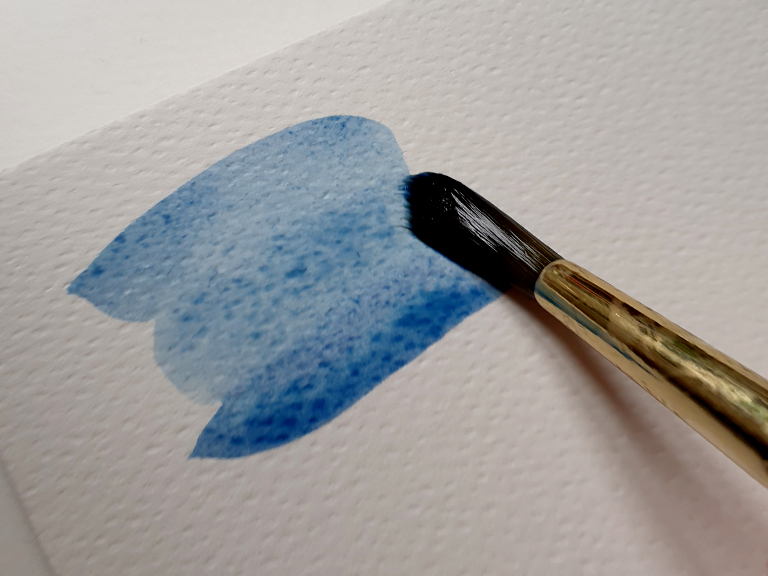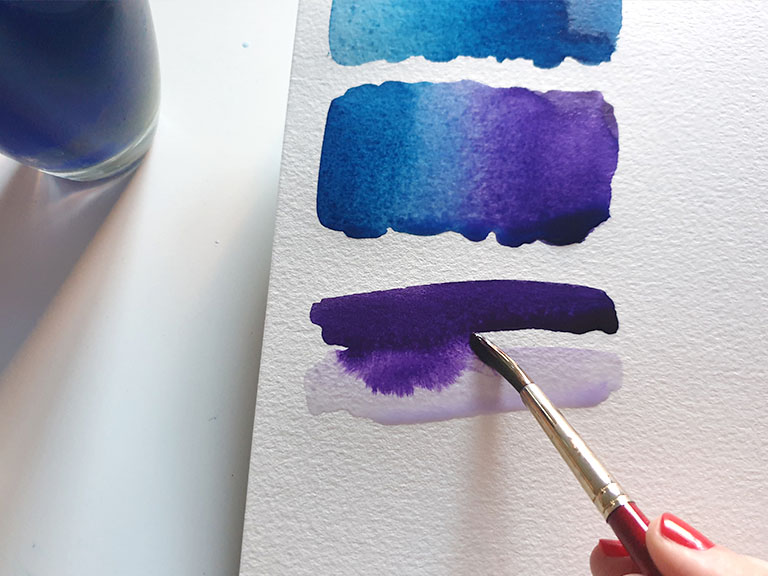Starting to paint can seem daunting because there are so many watercolour supplies to choose from! It’s very different from other mediums like oil and acrylics – the pigment in watercolour is delicate and you need soft brushes to make the most of it.
But if you walk into an art shop (or browse their websites) there are suddenly hundreds of watercolour brushes to choose from! So what should you be looking for? Here’s a rundown of the different types.
Anatomy of a watercolour brush
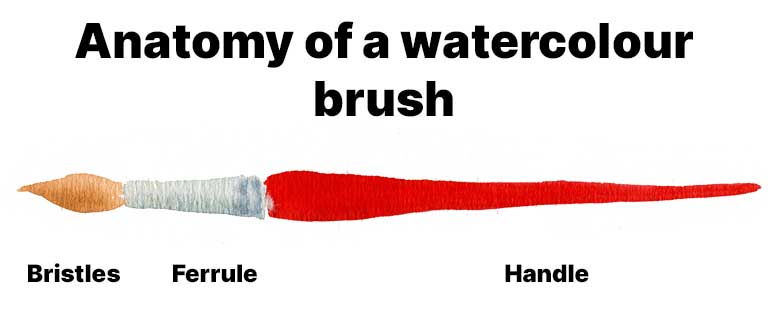
Watercolour brushes are made up of a handle, metal ferrule and the bristles.
Watercolour brush types by hair
Watercolour brushes can be made with animal hair or a synthetic version that mimics it. Generally, animal hair brushes hold a bit more water so you can paint for longer without having to reload. But synthetic brushes are cheaper, cruelty-free and can be easier to handle and care for.
Here are the most common types:
Sable watercolour brushes
Sable is the most common type of natural hair watercolour brush. Real sable brushes tend to be more expensive, and the priciest type is known as Kolinksy sable. Interestingly, the Kolinsky is not actually a sable but a type of weasel, though ‘weasel brushes’ sounds less appealing!
Sable brushes have a light, sandy colour and incredibly delicate bristles, making them ideal for watercolour pigment. It creates a smooth stroke and holds a lot of water in the natural hair.
Squirrel watercolour brushes
These brushes are darker and the hairs tend to be longer, making them a common material for mop brushes. Squirrel brushes are still soft and delicate like sable, and they have amazing properties for holding water.
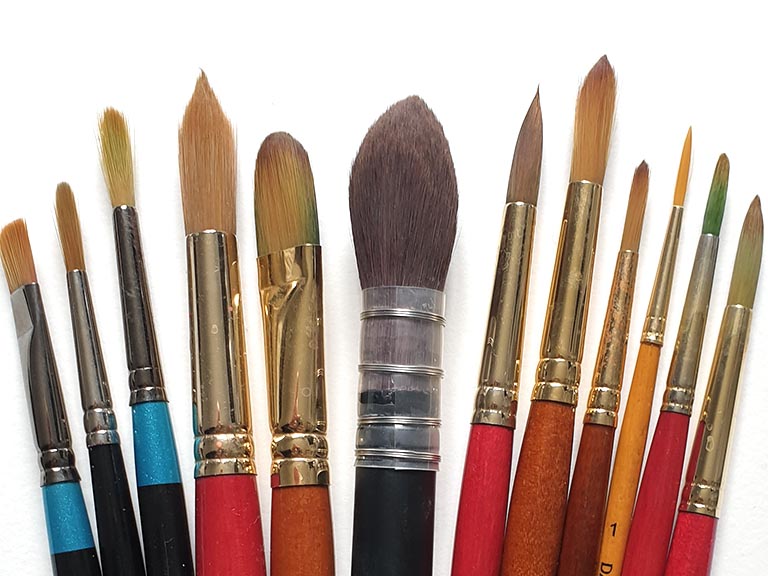
Ox and goat hair watercolour brushes
Watercolour brushes can also use other animal hair, including ox and goat hair brushes. These are slightly coarser than sable and squirrel, and the bristles tend to be a white colour. Generally, they are used for bigger brushes like mop or hake types, and can create interesting marks with your paint.
Synthetic watercolour brushes
Many watercolour artists are now using synthetic brushes, which are made of a golden nylon often called Taklon. They are very similar in performance to natural brushes, holding plenty of water and are often described as having more ‘snap’. This means that the bristles bend when you press down onto the paper, but snap back into position when you lift the brush up. Many beginners find this easier to control, but what you use is down to personal preference.
Watercolour brush types by shape
As well as having variation by hair type, there are lots of different shapes for watercolour brushes.
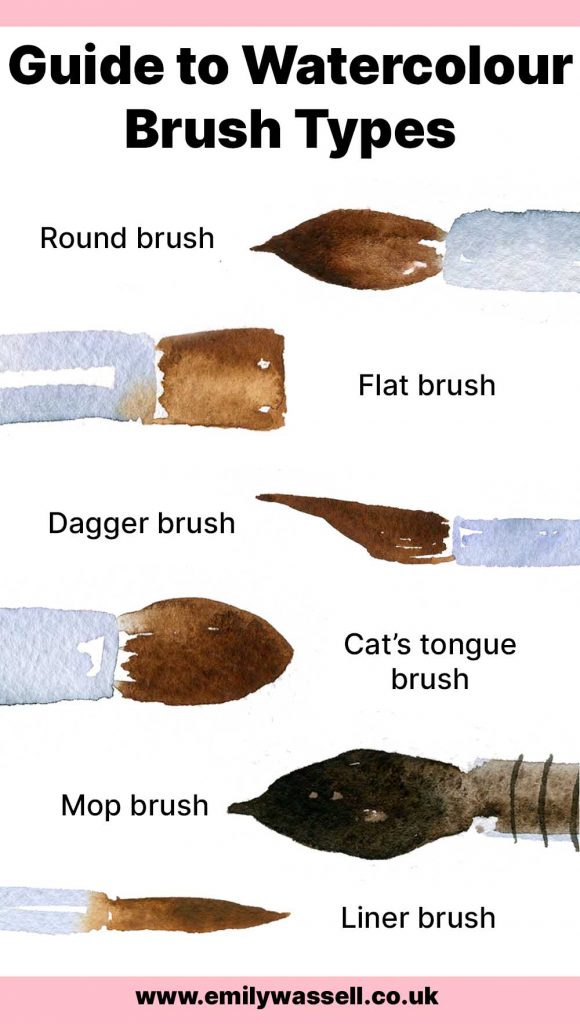
Round brushes
The most common brushes for watercolour are round brushes. These are named after the round ferrule (the metal part). They’re great for watercolour beginners because they work as two-in-one brushes, because they have a pointy tip that can be used to create fine strokes, and a wider belly where they are pressed down on the paper.
Brush sizes are numbered, and the bigger the number, the wider the brush. Many watercolourists use a size 6 round, which is a good medium size. You can use a smaller size like 2 for details, and a bigger size 12 or 16 for larger, looser work.
Top tip: look for a round brush with a pointy tip for the finest lines.
Mop brushes
Mop watercolour brushes are large round brushes that hold more water. They’re normally made from real animal hair and much softer than round brushes. The shape of the bristles will change as you work, without snapping back into place when you lift the brush back up. Mop brushes can be harder for beginners to control but they allow for a looser style of painting.
Be aware that mop brush sizes are different to regular round brushes – a size 6 mop will be very large – a size 0 is a good medium one.
Flat brushes
Flat watercolour brushes have a flat ferrule and usually short, squared bristles. They are great for lines, edges and geometric shapes, as well as watercolour washes. A large flat brush can cover the paper quickly, ensuring equal water content that’s great for blending.
Hake brushes
A hake brush is a large type of flat brush, often used for washes by getting an even spread of water across the entire paper. Great if you love landscapes and skies, hake brushes speed up the process by allowing you to get whole sections wet at once.
Cat’s tongue brushes
Cat’s tongue brushes a flat ferrule but the bristles are rounded over the edge, often coming to a slight point in the middle. They can be used flat to create oval shapes or on their sides to make interesting marks. Try twisting a cat’s tongue brush as you move through the stroke for unusual shapes.
Liner brushes or rigger
These watercolour brushes have long, thin bristles that are good for creating smooth long lines. Great for botanicals like grass or reeds, or for outlining your shapes in abstract pieces.
Brush pens
Brush pens are great for travelling or painting outside. These hollow plastic brushes allow you to carry water inside the handle, so you can squeeze the pen to push water into the bristles. It means you don’t need a jar of water as you travel so you can paint on the go. Unscrew them to load with water, squeeze and start painting!
Travel watercolour brushes
If you travel a lot or enjoy painting al fresco, travel watercolour brushes are a great addition to your painting supplies. They generally have a hollow metal handle that comes off to function as a lid, covering the delicate bristles so they don’t get damaged in your bag. They’re usually a type of round brush, so look out for the pointy tip.
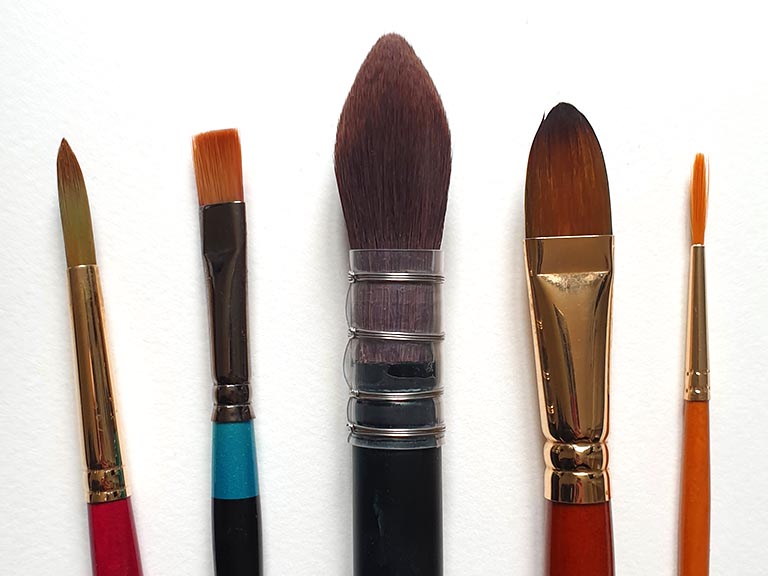
What watercolour brushes are best for me?
You’re going to hate this answer, but in all honesty… it depends! For me, round brushes are a good all-purpose watercolour brush that can be used to paint most subjects and styles. They’re what I started painting with, and still paint with most of the time. But other artists swear by mop brushes – it’s worth experimenting to see which suits you best.
Add other brushes to your kit as you experiment but they’re not essential – you can paint with just one brush!
Read this guide for more tips on buying the best watercolour brush for you!
And once you’ve found your perfect painting tools, read my guide on how to clean your watercolour brushes to make them last longer.
